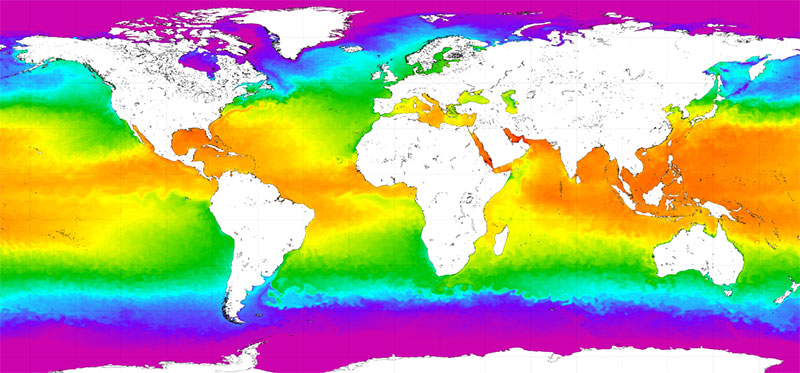As oceans warm, tropical fish are moving south. New friendships may be helping them survive – The Conversation

Report on the Poleward Migration of Tropical Fish and its Implications for Sustainable Development Goals
Recent research indicates a significant climate-driven shift in marine biodiversity, directly impacting the achievement of key Sustainable Development Goals (SDGs). The poleward migration of tropical fish species into temperate zones, a direct consequence of rising ocean temperatures, presents complex challenges and adaptive responses relevant to SDG 13 (Climate Action) and SDG 14 (Life Below Water).
Climate-Induced Species Redistribution: A Threat to SDG 14
The warming of oceans, a critical indicator of the global failure to meet SDG 13 targets, is facilitating a large-scale redistribution of marine life. This phenomenon is particularly evident along Australia’s east coast, where tropical fish are moving south into temperate reef systems.
Mechanisms of Migration
- Ocean Currents: The strengthening East Australian Current acts as a conduit, transporting warm water and tropical larvae hundreds of kilometres south of their native ranges.
- Winter Survival: Historically, migrant tropical fish would perish during colder winter months. However, rising minimum water temperatures now permit year-round survival, leading to the establishment of permanent populations in these new temperate habitats.
This “tropicalisation” of temperate reefs represents a fundamental alteration of marine ecosystems, posing a significant challenge to SDG 14.2, which calls for the sustainable management and protection of marine and coastal ecosystems to avoid significant adverse impacts.
Behavioral Adaptation and Interspecies Dynamics
A study analyzing the behavior of five tropical and two temperate fish species across a 2,000km transect revealed critical adaptive strategies employed by the migrant species.
Risk-Averse Behavior in Migrant Fish
In the unfamiliar, cooler temperate waters, tropical fish exhibited significant behavioral changes to mitigate risk:
- Increased time spent in shelter.
- Reduced time allocated to feeding.
- Heightened vigilance and faster escape responses when threatened.
While these behaviors enhance immediate survival, they compromise foraging and growth, potentially impacting the long-term viability of the population and the overall health of the ecosystem as outlined in SDG 14.
The Role of Interspecies Shoaling: A Natural Partnership for Resilience
The research identified a key mechanism that mitigates the negative trade-offs of risk-averse behavior: interspecies shoaling. This interaction can be viewed as a natural parallel to SDG 17 (Partnerships for the Goals), where collaboration enhances resilience.
When tropical damselfish formed mixed-species shoals with local temperate fish, they demonstrated remarkable behavioral plasticity, leading to improved outcomes:
- They spent significantly more time feeding and less time sheltering.
- They appeared bolder and were more successful in acquiring food.
- It is hypothesized that tropical fish learn about local food sources and predator risks from their temperate shoal mates, a form of social learning that accelerates adaptation.
Ecosystem-Level Consequences and Future Outlook for Marine Sustainability
The migration and subsequent adaptation of tropical species are not without negative consequences for the native ecosystem, creating new pressures that complicate efforts to achieve SDG 14.
Adverse Impacts on Temperate Species
The presence of tropical newcomers was observed to be detrimental to some native temperate fish. At the warmer edge of their range, temperate species in mixed shoals fled more often and fed less. This added competitive pressure, compounded by the stress of ocean warming, threatens the stability of local populations and the integrity of temperate reef ecosystems.
Limitations and Complexities
- Not all migrant species benefit from interspecies interactions. Herbivorous tropical fish with specialized diets, such as the convict tang, did not show the same adaptive benefits.
- These findings underscore that climate-driven range shifts are complex phenomena involving behavior, interspecies relationships, and resilience.
Understanding these nuanced interactions is essential for developing effective management strategies to protect marine biodiversity and ensure the long-term health of our oceans, a core objective of SDG 14 (Life Below Water), in an era of accelerating climate change.
1. Which SDGs are addressed or connected to the issues highlighted in the article?
The article primarily addresses issues related to the following Sustainable Development Goals:
-
SDG 13: Climate Action
This goal is central to the article, as the entire phenomenon discussed is a direct consequence of climate change. The text explicitly states, “When you think about climate change in our oceans, you may picture coral bleaching, melting sea ice, or extreme weather events. But beneath the ocean’s surface, another quiet shift is underway.” It further links the fish migration to warming waters: “As winter water temperatures increase, some tropical fish survive year-round in temperate reefs.”
-
SDG 14: Life Below Water
This goal is directly connected as the article focuses on the impacts of climate change on marine life and ecosystems. It describes the disruption of temperate marine ecosystems due to the influx of tropical species. The research aims to understand these changes to better manage marine environments, as stated in the conclusion: “Understanding how fish respond to their new neighbours and how those responses shape who stays and who goes, will be key to managing reefs in a rapidly warming ocean.”
2. What specific targets under those SDGs can be identified based on the article’s content?
Based on the article’s discussion, the following specific targets can be identified:
-
Target 13.1: Strengthen resilience and adaptive capacity to climate-related hazards and natural disasters in all countries.
The article provides a direct example of adaptive capacity in a non-human context. It details how some tropical fish exhibit “behavioural ‘plasticity'” which is described as “a powerful tool in a changing climate.” This adaptation, such as forming mixed shoals with temperate fish to learn about new environments, helps them survive and thrive, demonstrating resilience to climate-induced changes.
-
Target 14.2: By 2020, sustainably manage and protect marine and coastal ecosystems to avoid significant adverse impacts, including by strengthening their resilience, and take action for their restoration in order to achieve healthy and productive oceans.
The article highlights the adverse impacts on temperate reef ecosystems. The migration of tropical fish is called a “slow-motion invasion” that can “disrupt existing ecosystems and place extra stress on local temperate species.” The research described is a step toward understanding these impacts for future management, which is the core of this target.
-
Target 14.a: Increase scientific knowledge, develop research capacity and transfer marine technology… in order to improve ocean health and to enhance the contribution of marine biodiversity to the development of developing countries.
The entire article is based on “new research” aimed at increasing scientific knowledge about the effects of ocean warming. It details the study’s methodology (“underwater video cameras”) and findings, contributing directly to the body of scientific knowledge needed to understand and manage marine ecosystems in the face of climate change.
3. Are there any indicators mentioned or implied in the article that can be used to measure progress towards the identified targets?
Yes, the article mentions or implies several indicators that can be used to measure the impacts and adaptations discussed:
-
Indicators for Target 13.1 (Strengthen resilience and adaptive capacity):
- Behavioral Adaptation in Species: The article identifies specific adaptive behaviors in tropical fish, such as spending “more time feeding and less time sheltering when they formed mixed shoals with temperate fish.” Measuring the frequency and success of such behaviors serves as an indicator of adaptive capacity.
- Survival and Growth Rates: The research notes that when tropical fish shoal with temperate fish, they “grow bigger and survive longer into winter.” These survival and growth metrics are direct indicators of resilience.
-
Indicators for Target 14.2 (Manage and protect marine ecosystems):
- Species Range Shift: The article clearly indicates that tropical fish are moving south, with some showing up “hundreds of kilometres beyond their usual home range.” Tracking the geographic distribution of species over time is a key indicator of ecosystem change.
- Impact on Native Species: The study observed that for temperate fish, “the presence of tropical fish… were often problematic,” causing them to “fled more often and fed less.” These behavioral changes in native species are indicators of adverse impacts on the ecosystem.
-
Indicators for Target 14.a (Increase scientific knowledge):
- Publication of Scientific Research: The article itself, which is a summary of a published study (“new research we studied…”), is an indicator of an increase in scientific knowledge.
- Development of Observational Methods: The use of “underwater video cameras” to study fish behavior in their natural habitat is a specific research method that contributes to our capacity to monitor and understand marine life.
4. Table of SDGs, Targets, and Indicators
| SDGs | Targets | Indicators |
|---|---|---|
| SDG 13: Climate Action | 13.1: Strengthen resilience and adaptive capacity to climate-related hazards. |
|
| SDG 14: Life Below Water | 14.2: Sustainably manage and protect marine and coastal ecosystems to avoid significant adverse impacts. |
|
| SDG 14: Life Below Water | 14.a: Increase scientific knowledge and develop research capacity. |
|
Source: au.news.yahoo.com

What is Your Reaction?
 Like
0
Like
0
 Dislike
0
Dislike
0
 Love
0
Love
0
 Funny
0
Funny
0
 Angry
0
Angry
0
 Sad
0
Sad
0
 Wow
0
Wow
0









































































